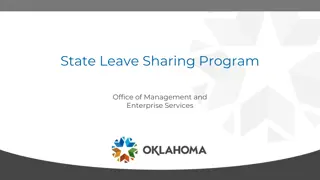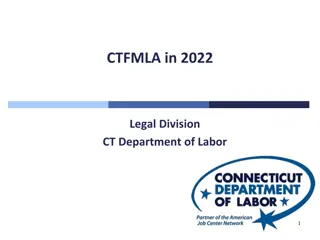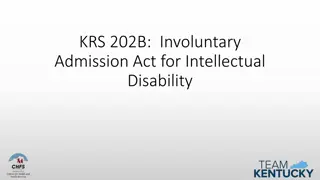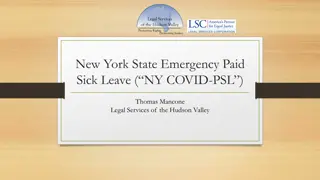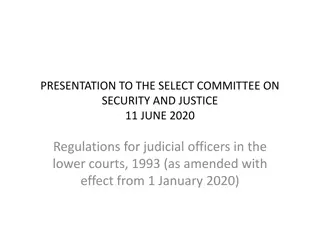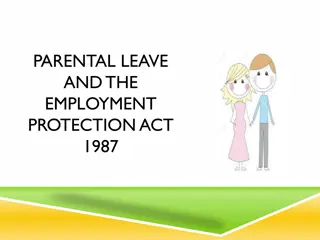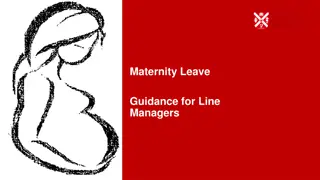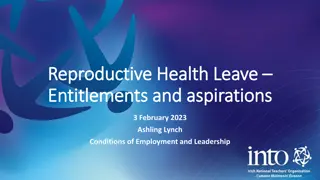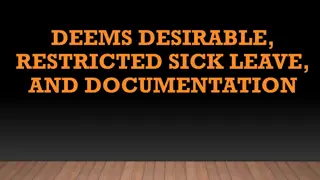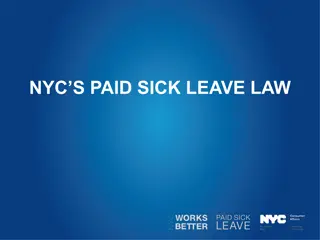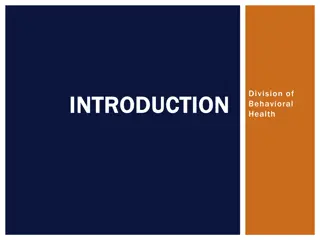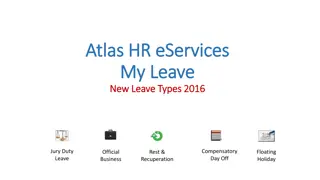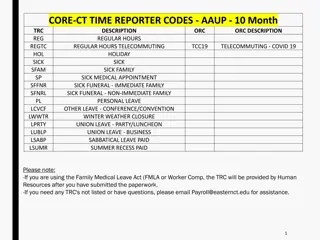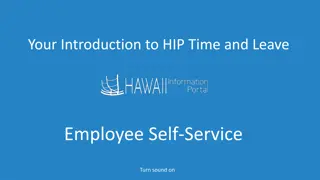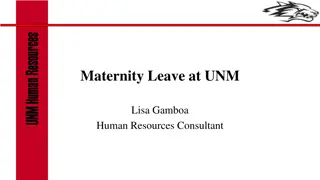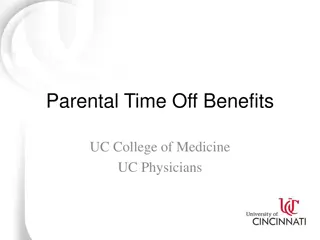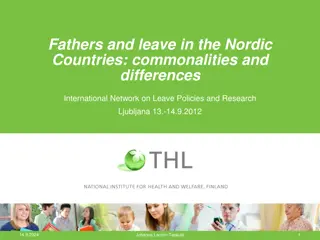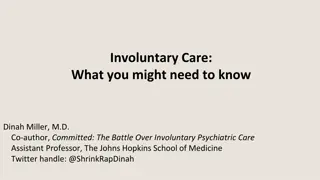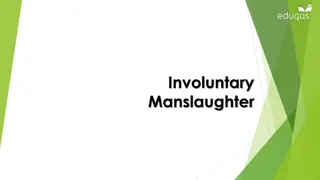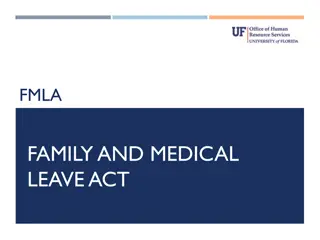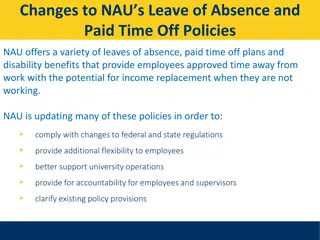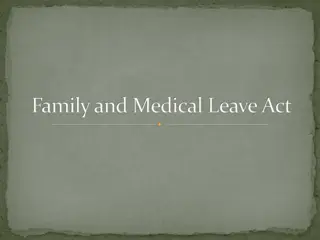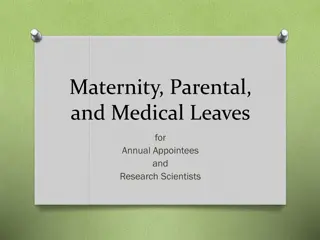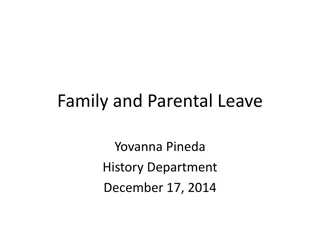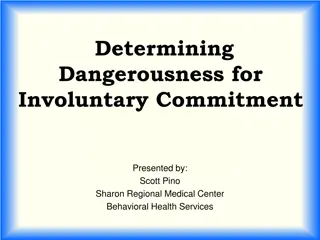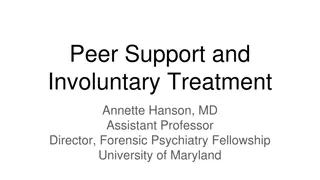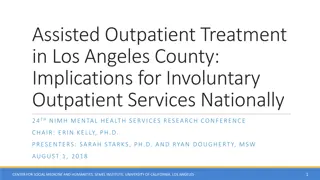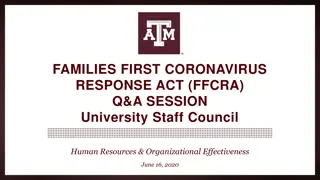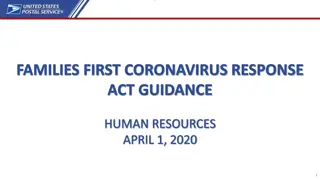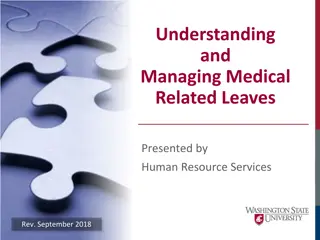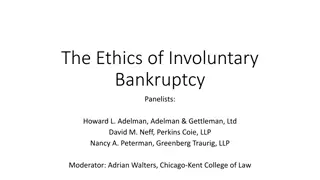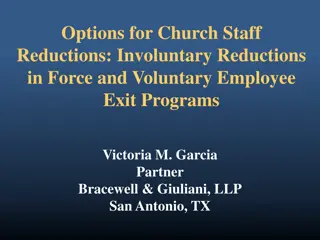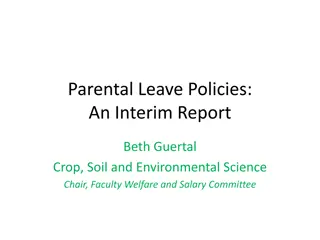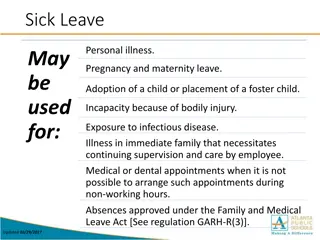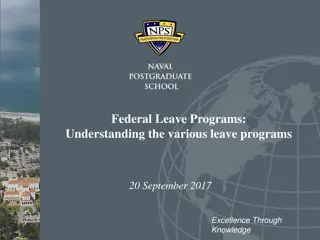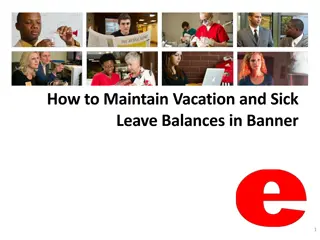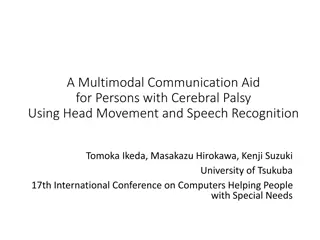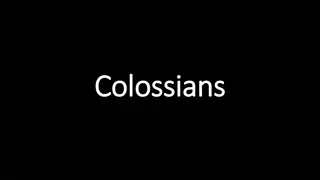Understanding Family and Medical Leave Act (FMLA)
The Family and Medical Leave Act (FMLA) is a federal law that provides eligible employees with unpaid, job-protected leave for specified family and medical reasons. This training covers employer coverage, employee eligibility, qualifying reasons for leave, basic provisions of the law, employer requi
1 views • 31 slides
Cadets Code of Conduct During Leave
Cadets must adhere to a set of guidelines before dispersal for leave, including safe custody of belongings, coordination of transport, and strict adherence to timings. During leave, they are required to travel in decent dress, take care of personal safety, and not discuss college matters in public.
1 views • 6 slides
State Leave Sharing Program Overview
State Leave Sharing Program, managed by the Office of Management and Enterprise Services, allows state employees to donate annual or sick leave to colleagues in need. Eligibility criteria, donation rules, and the Leave of Last Resort Bank are outlined. Employees facing extraordinary circumstances li
0 views • 14 slides
Overview of Leave Laws and Job Protection Guidelines
Providing a comprehensive overview of various leave laws, job-protected leave, and income replacement options for employees in Connecticut, including details on Federal FMLA, CT Paid Leave, CTFMLA, Workers Compensation, Paid Sick Leave, Americans with Disabilities Act, Pregnancy Disability Act, and
2 views • 66 slides
Understanding Kentucky's KRS.202B Involuntary Admission Act for Intellectual Disability
Kentucky's KRS.202B allows for the involuntary admission of individuals with intellectual disabilities to Intermediate Care Facilities for Individuals with Intellectual Disability (ICF/IID). The process involves filing a petition in district court, evaluation by two certified evaluators, and coordin
0 views • 25 slides
New York State Emergency Paid Sick Leave (NY COVID-PSL) Guidelines
NY COVID-PSL provides requirements for sick leave and certain employee benefits when subject to a quarantine or isolation order due to COVID-19. Small, medium, and large employers have different obligations for providing paid and unpaid leave based on their business size. Eligible employees can util
1 views • 25 slides
Regulations for Judicial Officers in Lower Courts: Presentation to Select Committee
This presentation outlines the regulations governing judicial officers in lower courts, focusing on leave categories, vacation leave provisioning, and the vacation leave cycle. It highlights the historical background, the Magistrates Act of 1993, and the recent amendments effective from January 1, 2
4 views • 26 slides
Parental Leave and Employment Protection Act 1987 Overview
The Parental Leave and Employment Protection Act 1987 provides minimum entitlements for parental leave, protects employees during pregnancy and parental leave, and allows for up to 22 weeks of parental leave payments. Eligibility criteria include female employees with a baby, their spouses or partne
1 views • 42 slides
Maternity Leave Guidance for Line Managers at the University
The Maternity Leave Guidance for Line Managers at the University emphasizes compassion and support for expectant mothers. It outlines essential steps for line managers before, during, and after maternity leave, including notifying HR of pregnancy, conducting risk assessments, discussing leave plans,
0 views • 8 slides
Reproductive Health Leave Entitlements and Challenges Faced by Teachers
This presentation explores various aspects of reproductive health leave for teachers, including pregnancy-related sick leave, fertility treatment leave, family leave for parents, and more. It discusses current conditions, challenges faced, and potential solutions in the education sector. Attendees w
4 views • 36 slides
USPS Sick Leave Policies and Documentation Requirements
USPS has strict attendance policies regarding sick leave, including requirements for documentation and restricted sick leave. Employees are expected to maintain regular attendance, provide evidence for absences when necessary, and follow specific guidelines for sick leave documentation. Restricted s
0 views • 16 slides
Understanding NYC Paid Sick Leave Law
NYC Paid Sick Leave Law ensures employees have access to sick leave for themselves or family members. Employers must provide paid or unpaid sick leave based on the number of employees. The law covers various family members, including children, grandparents, and siblings. The Department of Consumer A
0 views • 34 slides
Understanding Involuntary Commitment Criteria for Adults with Serious Mental Illness
Involuntary commitment for adults with serious mental illness is a sensitive issue that involves specific criteria to determine if someone poses a danger to themselves or others. The criteria include having a serious mental illness, being a threat to self or others, or having an inability to provide
0 views • 67 slides
Atlas HR eServices - Leave Types and Application Procedures
This content provides detailed information on various leave types and application procedures within the Atlas HR eServices platform. It covers topics such as Jury Duty Leave, Compensatory Day Off, Floating Holiday (NY), Official Business, Rest & Recuperation, along with guidelines on how to apply fo
0 views • 12 slides
Core-CT Time Reporter Codes and Descriptions for AAUP Employees
This document provides detailed time reporter codes and descriptions for AAUP employees working on a 10-month or 12-month schedule. It includes information on regular hours, telecommuting, holidays, sick leave, family medical leave, personal leave, vacation, union leave, sabbatical leave, and more.
0 views • 7 slides
Streamlining Your Time and Leave Management with HIP Employee Self-Service
Discover how Hawaii's HIP Time and Leave system revolutionizes the way employees handle timesheets and leave requests. Learn about submitting records online, getting supervisor approval, using Leave tiles efficiently, finding leave balances, submitting sick time requests, and managing partial days.
0 views • 31 slides
Maternity and Family Leave Policies at UNM
Maternity leave at UNM is not a designated leave type, but employees can utilize Family Medical Leave (FMLA) for pregnancy, childbirth, adoption, or foster care needs. FMLA allows eligible employees up to twelve weeks of job-protected leave for specific family-related reasons. Additionally, sick lea
0 views • 7 slides
Understanding Parental Leave Benefits in the Workplace
Parental leave is an essential aspect of work benefits, providing time off for new parents to care for their newborn or newly adopted child. This comprehensive guide covers different types of parental leave, factors to consider, global comparisons, the Family Medical Leave Act (FMLA), employer benef
0 views • 17 slides
Fathers and Parental Leave Policies in the Nordic Countries: Insights and Challenges
The Nordic countries have a long history of promoting parental leave and gender equality. Despite progressive policies, challenges remain in achieving equal parental leave uptake between mothers and fathers. This impacts women's position in the labor market and men's role in the family. The high fer
0 views • 13 slides
Understanding the Battle Over Involuntary Psychiatric Care
Explore the complexities surrounding involuntary psychiatric care, including standards for commitment, patient rights, and differing perspectives from organizations like The Treatment Advocacy Center, NAMI, and The American Psychiatric Association.
0 views • 38 slides
Understanding Involuntary Manslaughter: Forms and Elements
Involuntary Manslaughter encompasses two forms: Manslaughter by Unlawful and Dangerous Act and Gross Negligence Manslaughter. The former requires an unlawful act causing death, while the latter involves gross negligence leading to a fatality. Acts must be both unlawful and dangerous to constitute th
0 views • 29 slides
FMLA - Family and Medical Leave Act Overview
The Family and Medical Leave Act (FMLA) provides unpaid, job-protected leave for specific family and medical reasons. Eligible employees can take up to 12 workweeks of leave in a 12-month period, allowing for bonding with a new child, caring for a family member with a serious health condition, takin
0 views • 26 slides
Updates to NAU's Leave of Absence and Paid Time Off Policies
NAU is updating its leave of absence and paid time off policies to comply with regulations, provide flexibility to employees, support university operations, ensure accountability, and clarify existing provisions. The changes include revising existing policies, creating new ones, and addressing aspec
0 views • 10 slides
Understanding the Family and Medical Leave Act (FMLA)
The Family and Medical Leave Act (FMLA) allows eligible employees to take unpaid leave for up to 12 weeks for specific family and medical reasons. The FMLA aims to promote work-life balance, economic security, and family integrity. This act was signed into law by President Bill Clinton in 1993 and h
0 views • 33 slides
Maternity, Parental, and Medical Leave Policies for Academic Appointees
Maternity, parental, and medical leave policies for annual appointees and research scientists, including details on eligibility, duration, financing, payment rates, and leave supplementation options. Processes and forms required for taking maternity leave are also outlined, ensuring a smooth transit
0 views • 22 slides
Family and Parental Leave Insights: U.S. and Global Perspectives
Understanding family and parental leave policies is crucial for creating a supportive work environment. This content highlights the availability of paid maternity leave in various countries, the financial implications of unpaid leave for women, and challenges faced by individuals in requesting paren
0 views • 15 slides
Understanding Mental Health Procedures for Involuntary Commitment
The Mental Health Procedures Act, enacted in 1976 and amended in 1978, provides guidelines for the treatment of individuals with mental illness, emphasizing voluntary treatment over involuntary. It outlines criteria, such as evidence of severe mental illness and dangerous behavior, for pursuing invo
0 views • 32 slides
Evolution of Involuntary Treatment in Mental Health Care
The evolution of involuntary treatment in mental health care spans from the 18th and 19th centuries marked by social reform efforts to present-day practices with common elements across states. Notable figures like Dorothea Dix and Mrs. E. P. W. Packard contributed to raising awareness and improving
0 views • 21 slides
Assisted Outpatient Treatment in Los Angeles County: Implications for National Services
The symposium discusses Assisted Outpatient Treatment (AOT) in Los Angeles County, exploring topics such as family involvement, barriers, voluntary vs. involuntary enrollment, violence, and victimization. Presenters highlight the importance of addressing inadequate access to mental health care and p
0 views • 80 slides
Understanding Families First Coronavirus Response Act (FFCRA)
The Families First Coronavirus Response Act (FFCRA) provides essential information on leave types, eligibility, paid leave provisions, and access for employees impacted by COVID-19. It covers Emergency Paid Sick Leave (EPSL), Emergency Family and Medical Leave (EFMLA), and the qualifications for acc
0 views • 12 slides
Families First Coronavirus Response Act Guidance
The Families First Coronavirus Response Act (FFCRA) provides employees with Emergency Paid Sick Leave and expanded Family and Medical Leave due to COVID-19 related circumstances. The Act is effective from April 1, 2020, through December 31, 2020, offering up to 80 hours of Emergency Paid Sick Leave
0 views • 16 slides
Managing Medical Leaves: Comprehensive Guide for HR Professionals
This presentation delves into understanding and managing different types of medical-related leaves in the workplace, covering various leave provisions, benefits provided by law and policies, interplay between provisions and leave types, general rules for using leave, and specifics of Family Medical
0 views • 47 slides
Ethical Considerations in Involuntary Bankruptcy Cases
This content discusses three scenarios involving ethical dilemmas in the context of involuntary bankruptcy filings. From managers filing against fellow LLC members to lenders initiating bankruptcies for strategic reasons, the scenarios highlight complex issues such as creditor solicitation, usury de
0 views • 6 slides
Effective Strategies for Church Staff Reductions: Involuntary and Voluntary Options
Explore effective strategies for church staff reductions, including involuntary reductions in force and voluntary employee exit programs. Learn about salary freezes, attrition reductions, and reduced work schedules/furloughs to navigate challenging situations while ensuring compliance with employmen
0 views • 36 slides
Understanding Parental Leave Policies: An Overview
The Family and Medical Leave Act (FMLA) provides eligible employees with unpaid, job-protected leave for various family and medical reasons. FMLA allows for up to twelve workweeks of leave in a 12-month period for situations like the birth or adoption of a child, caring for a family member with a se
0 views • 18 slides
Sick Leave Policy Overview
Sick leave policy allows employees to take time off for personal illness, pregnancy, adoption, and other medical reasons. Approval processes, reporting requirements, and conditions for extended or unused sick leave are outlined. Unused sick leave may be compensated upon retirement. Violations of sic
0 views • 6 slides
Understanding Federal Leave Programs Overview
This overview provides insight into various federal leave programs, including annual, sick, and family leave, as well as programs like FMLA and LWOP. It discusses accrual rates, approval processes, usage limits, and requirements for sick leave. The overview aims to enhance understanding and complian
0 views • 18 slides
Efficient Management of Vacation and Sick Leave Balances
Proper maintenance of vacation and sick leave balances in Banner involves updating accruals regularly via time entry or payroll processes. Leave benefits are position-dependent and tracked in the HR system by category. Appendix A provides details on leave codes and corresponding leave categories for
0 views • 14 slides
Assistive Communication System for Individuals with Cerebral Palsy Using Head Movement and Speech Recognition
Development of a multimodal communication aid system for individuals with cerebral palsy, addressing challenges such as dysarthria and involuntary movements. The system allows users to communicate through head movements and speech recognition, reducing the reliance on caregivers and minimizing disru
0 views • 15 slides
Understanding Involuntary and Voluntary Movements in the Body
Involuntary movements, such as contraction and relaxation, are controlled by the autonomic nervous system and are essential for daily functions like heartbeat regulation. On the other hand, voluntary movements involve conscious control over skeletal muscles to regulate body movement. Biblical verses
1 views • 54 slides


